[English] 日本語
 Yorodumi
Yorodumi- EMDB-33133: SARS-CoV-2 S ectodomain trimer in complex with neutralizing antib... -
+ Open data
Open data
- Basic information
Basic information
| Entry |  | |||||||||
|---|---|---|---|---|---|---|---|---|---|---|
| Title | SARS-CoV-2 S ectodomain trimer in complex with neutralizing antibody 10-5B | |||||||||
 Map data Map data | ||||||||||
 Sample Sample |
| |||||||||
 Keywords Keywords | SARS-CoV-2 / antibody / VIRAL PROTEIN/IMMUNE SYSTEM / VIRAL PROTEIN-IMMUNE SYSTEM complex | |||||||||
| Function / homology |  Function and homology information Function and homology informationMaturation of spike protein / viral translation / Translation of Structural Proteins / Virion Assembly and Release / host cell surface / host extracellular space / suppression by virus of host tetherin activity / Induction of Cell-Cell Fusion / structural constituent of virion / entry receptor-mediated virion attachment to host cell ...Maturation of spike protein / viral translation / Translation of Structural Proteins / Virion Assembly and Release / host cell surface / host extracellular space / suppression by virus of host tetherin activity / Induction of Cell-Cell Fusion / structural constituent of virion / entry receptor-mediated virion attachment to host cell / host cell endoplasmic reticulum-Golgi intermediate compartment membrane / membrane fusion / receptor-mediated endocytosis of virus by host cell / Attachment and Entry / positive regulation of viral entry into host cell / receptor-mediated virion attachment to host cell / receptor ligand activity / symbiont-mediated suppression of host innate immune response / host cell surface receptor binding / fusion of virus membrane with host plasma membrane / fusion of virus membrane with host endosome membrane / viral envelope / virion attachment to host cell / SARS-CoV-2 activates/modulates innate and adaptive immune responses / host cell plasma membrane / virion membrane / identical protein binding / membrane / plasma membrane Similarity search - Function | |||||||||
| Biological species |   Homo sapiens (human) Homo sapiens (human) | |||||||||
| Method | single particle reconstruction / cryo EM / Resolution: 3.3 Å | |||||||||
 Authors Authors | Wang X / Wang Z | |||||||||
| Funding support | 1 items
| |||||||||
 Citation Citation |  Journal: Nat Commun / Year: 2023 Journal: Nat Commun / Year: 2023Title: Inactivated vaccine-elicited potent antibodies can broadly neutralize SARS-CoV-2 circulating variants. Authors: Yubin Liu / Ziyi Wang / Xinyu Zhuang / Shengnan Zhang / Zhicheng Chen / Yan Zou / Jie Sheng / Tianpeng Li / Wanbo Tai / Jinfang Yu / Yanqun Wang / Zhaoyong Zhang / Yunfeng Chen / Liangqin ...Authors: Yubin Liu / Ziyi Wang / Xinyu Zhuang / Shengnan Zhang / Zhicheng Chen / Yan Zou / Jie Sheng / Tianpeng Li / Wanbo Tai / Jinfang Yu / Yanqun Wang / Zhaoyong Zhang / Yunfeng Chen / Liangqin Tong / Xi Yu / Linjuan Wu / Dong Chen / Renli Zhang / Ningyi Jin / Weijun Shen / Jincun Zhao / Mingyao Tian / Xinquan Wang / Gong Cheng /  Abstract: A full understanding of the inactivated COVID-19 vaccine-mediated antibody responses to SARS-CoV-2 circulating variants will inform vaccine effectiveness and vaccination development strategies. Here, ...A full understanding of the inactivated COVID-19 vaccine-mediated antibody responses to SARS-CoV-2 circulating variants will inform vaccine effectiveness and vaccination development strategies. Here, we offer insights into the inactivated vaccine-induced antibody responses after prime-boost vaccination at both the polyclonal and monoclonal levels. We characterized the VDJ sequence of 118 monoclonal antibodies (mAbs) and found that 20 neutralizing mAbs showed varied potency and breadth against a range of variants including XBB.1.5, BQ.1.1, and BN.1. Bispecific antibodies (bsAbs) based on nonoverlapping mAbs exhibited enhanced neutralizing potency and breadth against the most antibody-evasive strains, such as XBB.1.5, BQ.1.1, and BN.1. The passive transfer of mAbs or their bsAb effectively protected female hACE2 transgenic mice from challenge with an infectious Delta or Omicron BA.2 variant. The neutralization mechanisms of these antibodies were determined by structural characterization. Overall, a broad spectrum of potent and distinct neutralizing antibodies can be induced in individuals immunized with the SARS-CoV-2 inactivated vaccine BBIBP-CorV, suggesting the application potential of inactivated vaccines and these antibodies for preventing infection by SARS-CoV-2 circulating variants. | |||||||||
| History |
|
- Structure visualization
Structure visualization
| Supplemental images |
|---|
- Downloads & links
Downloads & links
-EMDB archive
| Map data |  emd_33133.map.gz emd_33133.map.gz | 118 MB |  EMDB map data format EMDB map data format | |
|---|---|---|---|---|
| Header (meta data) |  emd-33133-v30.xml emd-33133-v30.xml emd-33133.xml emd-33133.xml | 17.3 KB 17.3 KB | Display Display |  EMDB header EMDB header |
| Images |  emd_33133.png emd_33133.png | 52.8 KB | ||
| Filedesc metadata |  emd-33133.cif.gz emd-33133.cif.gz | 6.4 KB | ||
| Others |  emd_33133_half_map_1.map.gz emd_33133_half_map_1.map.gz emd_33133_half_map_2.map.gz emd_33133_half_map_2.map.gz | 116.2 MB 116.2 MB | ||
| Archive directory |  http://ftp.pdbj.org/pub/emdb/structures/EMD-33133 http://ftp.pdbj.org/pub/emdb/structures/EMD-33133 ftp://ftp.pdbj.org/pub/emdb/structures/EMD-33133 ftp://ftp.pdbj.org/pub/emdb/structures/EMD-33133 | HTTPS FTP |
-Validation report
| Summary document |  emd_33133_validation.pdf.gz emd_33133_validation.pdf.gz | 869.2 KB | Display |  EMDB validaton report EMDB validaton report |
|---|---|---|---|---|
| Full document |  emd_33133_full_validation.pdf.gz emd_33133_full_validation.pdf.gz | 868.7 KB | Display | |
| Data in XML |  emd_33133_validation.xml.gz emd_33133_validation.xml.gz | 14.1 KB | Display | |
| Data in CIF |  emd_33133_validation.cif.gz emd_33133_validation.cif.gz | 16.7 KB | Display | |
| Arichive directory |  https://ftp.pdbj.org/pub/emdb/validation_reports/EMD-33133 https://ftp.pdbj.org/pub/emdb/validation_reports/EMD-33133 ftp://ftp.pdbj.org/pub/emdb/validation_reports/EMD-33133 ftp://ftp.pdbj.org/pub/emdb/validation_reports/EMD-33133 | HTTPS FTP |
-Related structure data
| Related structure data | 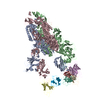 7xd2MC 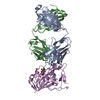 7x2hC 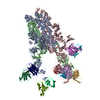 8h07C 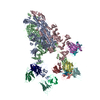 8h08C M: atomic model generated by this map C: citing same article ( |
|---|---|
| Similar structure data | Similarity search - Function & homology  F&H Search F&H Search |
- Links
Links
| EMDB pages |  EMDB (EBI/PDBe) / EMDB (EBI/PDBe) /  EMDataResource EMDataResource |
|---|---|
| Related items in Molecule of the Month |
- Map
Map
| File |  Download / File: emd_33133.map.gz / Format: CCP4 / Size: 125 MB / Type: IMAGE STORED AS FLOATING POINT NUMBER (4 BYTES) Download / File: emd_33133.map.gz / Format: CCP4 / Size: 125 MB / Type: IMAGE STORED AS FLOATING POINT NUMBER (4 BYTES) | ||||||||||||||||||||||||||||||||||||
|---|---|---|---|---|---|---|---|---|---|---|---|---|---|---|---|---|---|---|---|---|---|---|---|---|---|---|---|---|---|---|---|---|---|---|---|---|---|
| Projections & slices | Image control
Images are generated by Spider. | ||||||||||||||||||||||||||||||||||||
| Voxel size | X=Y=Z: 0.97 Å | ||||||||||||||||||||||||||||||||||||
| Density |
| ||||||||||||||||||||||||||||||||||||
| Symmetry | Space group: 1 | ||||||||||||||||||||||||||||||||||||
| Details | EMDB XML:
|
-Supplemental data
-Half map: #2
| File | emd_33133_half_map_1.map | ||||||||||||
|---|---|---|---|---|---|---|---|---|---|---|---|---|---|
| Projections & Slices |
| ||||||||||||
| Density Histograms |
-Half map: #1
| File | emd_33133_half_map_2.map | ||||||||||||
|---|---|---|---|---|---|---|---|---|---|---|---|---|---|
| Projections & Slices |
| ||||||||||||
| Density Histograms |
- Sample components
Sample components
-Entire : spike+antibody
| Entire | Name: spike+antibody |
|---|---|
| Components |
|
-Supramolecule #1: spike+antibody
| Supramolecule | Name: spike+antibody / type: complex / ID: 1 / Parent: 0 / Macromolecule list: all |
|---|---|
| Source (natural) | Organism:  |
-Macromolecule #1: Spike glycoprotein
| Macromolecule | Name: Spike glycoprotein / type: protein_or_peptide / ID: 1 / Number of copies: 3 / Enantiomer: LEVO |
|---|---|
| Source (natural) | Organism:  |
| Molecular weight | Theoretical: 143.540484 KDa |
| Recombinant expression | Organism:  Homo sapiens (human) Homo sapiens (human) |
| Sequence | String: MFVFLVLLPL VSSQCVNLTT RTQLPPAYTN SFTRGVYYPD KVFRSSVLHS TQDLFLPFFS NVTWFHAIHV SGTNGTKRFD NPVLPFNDG VYFASTEKSN IIRGWIFGTT LDSKTQSLLI VNNATNVVIK VCEFQFCNDP FLGVYYHKNN KSWMESEFRV Y SSANNCTF ...String: MFVFLVLLPL VSSQCVNLTT RTQLPPAYTN SFTRGVYYPD KVFRSSVLHS TQDLFLPFFS NVTWFHAIHV SGTNGTKRFD NPVLPFNDG VYFASTEKSN IIRGWIFGTT LDSKTQSLLI VNNATNVVIK VCEFQFCNDP FLGVYYHKNN KSWMESEFRV Y SSANNCTF EYVSQPFLMD LEGKQGNFKN LREFVFKNID GYFKIYSKHT PINLVRDLPQ GFSALEPLVD LPIGINITRF QT LLALHRS YLTPGDSSSG WTAGAAAYYV GYLQPRTFLL KYNENGTITD AVDCALDPLS ETKCTLKSFT VEKGIYQTSN FRV QPTESI VRFPNITNLC PFGEVFNATR FASVYAWNRK RISNCVADYS VLYNSASFST FKCYGVSPTK LNDLCFTNVY ADSF VIRGD EVRQIAPGQT GKIADYNYKL PDDFTGCVIA WNSNNLDSKV GGNYNYLYRL FRKSNLKPFE RDISTEIYQA GSTPC NGVE GFNCYFPLQS YGFQPTNGVG YQPYRVVVLS FELLHAPATV CGPKKSTNLV KNKCVNFNFN GLTGTGVLTE SNKKFL PFQ QFGRDIADTT DAVRDPQTLE ILDITPCSFG GVSVITPGTN TSNQVAVLYQ DVNCTEVPVA IHADQLTPTW RVYSTGS NV FQTRAGCLIG AEHVNNSYEC DIPIGAGICA SYQTQTNSPG SASSVASQSI IAYTMSLGAE NSVAYSNNSI AIPTNFTI S VTTEILPVSM TKTSVDCTMY ICGDSTECSN LLLQYGSFCT QLNRALTGIA VEQDKNTQEV FAQVKQIYKT PPIKDFGGF NFSQILPDPS KPSKRSFIED LLFNKVTLAD AGFIKQYGDC LGDIAARDLI CAQKFNGLTV LPPLLTDEMI AQYTSALLAG TITSGWTFG AGAALQIPFA MQMAYRFNGI GVTQNVLYEN QKLIANQFNS AIGKIQDSLS STASALGKLQ DVVNQNAQAL N TLVKQLSS NFGAISSVLN DILSRLDPPE AEVQIDRLIT GRLQSLQTYV TQQLIRAAEI RASANLAATK MSECVLGQSK RV DFCGKGY HLMSFPQSAP HGVVFLHVTY VPAQEKNFTT APAICHDGKA HFPREGVFVS NGTHWFVTQR NFYEPQIITT DNT FVSGNC DVVIGIVNNT VYDPLQPELD SFKEELDKYF KNHTSPDVDL GDISGINASV VNIQKEIDRL NEVAKNLNES LIDL QELGK YEQGSGYIPE APRDGQAYVR KDGEWVLLST FLGRSLEVLF QGPGHHHHHH HHSAWSHPQF EKGGGSGGGG SGGSA WSHP QFEKGSDYKD DDDK UniProtKB: Spike glycoprotein |
-Macromolecule #2: H chain of antibody 10-5B
| Macromolecule | Name: H chain of antibody 10-5B / type: protein_or_peptide / ID: 2 / Number of copies: 3 / Enantiomer: LEVO |
|---|---|
| Source (natural) | Organism:  Homo sapiens (human) Homo sapiens (human) |
| Molecular weight | Theoretical: 12.517014 KDa |
| Recombinant expression | Organism:  Homo sapiens (human) Homo sapiens (human) |
| Sequence | String: EVQLVESGGG LIQPGGSLRL SCAVSGFTVS RMSWVRQAPG KGLECVSVIY TGGNTDYADS VKGRFTISRD NSKNTLYLQM NSLRAEDTA LYYCVRGSGG IHDAFDIWGQ GTMVTVSS |
-Macromolecule #3: L chian of antibody 10-5B
| Macromolecule | Name: L chian of antibody 10-5B / type: protein_or_peptide / ID: 3 / Number of copies: 3 / Enantiomer: LEVO |
|---|---|
| Source (natural) | Organism:  Homo sapiens (human) Homo sapiens (human) |
| Molecular weight | Theoretical: 11.368661 KDa |
| Recombinant expression | Organism:  Homo sapiens (human) Homo sapiens (human) |
| Sequence | String: DIQMTQSPSS VSASVGDRVT ITCRASQGIS TWLAWYQQKP GKAPKVLINA ASGLQSGVPS RFSGSGSGTD FTLTISSLQP EDFATYYCQ QAHSFPPTFG PGTKLEIK |
-Experimental details
-Structure determination
| Method | cryo EM |
|---|---|
 Processing Processing | single particle reconstruction |
| Aggregation state | particle |
- Sample preparation
Sample preparation
| Buffer | pH: 8 |
|---|---|
| Vitrification | Cryogen name: ETHANE |
- Electron microscopy
Electron microscopy
| Microscope | FEI TITAN KRIOS |
|---|---|
| Image recording | Film or detector model: GATAN K3 (6k x 4k) / Average electron dose: 50.0 e/Å2 |
| Electron beam | Acceleration voltage: 300 kV / Electron source:  FIELD EMISSION GUN FIELD EMISSION GUN |
| Electron optics | Illumination mode: FLOOD BEAM / Imaging mode: BRIGHT FIELD / Nominal defocus max: 1.5 µm / Nominal defocus min: 1.2 µm |
| Experimental equipment |  Model: Titan Krios / Image courtesy: FEI Company |
- Image processing
Image processing
| Startup model | Type of model: PDB ENTRY PDB model - PDB ID: |
|---|---|
| Final reconstruction | Resolution.type: BY AUTHOR / Resolution: 3.3 Å / Resolution method: FSC 0.143 CUT-OFF / Number images used: 368416 |
| Initial angle assignment | Type: MAXIMUM LIKELIHOOD |
| Final angle assignment | Type: MAXIMUM LIKELIHOOD |
 Movie
Movie Controller
Controller


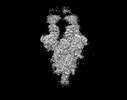






 Z (Sec.)
Z (Sec.) Y (Row.)
Y (Row.) X (Col.)
X (Col.)





































